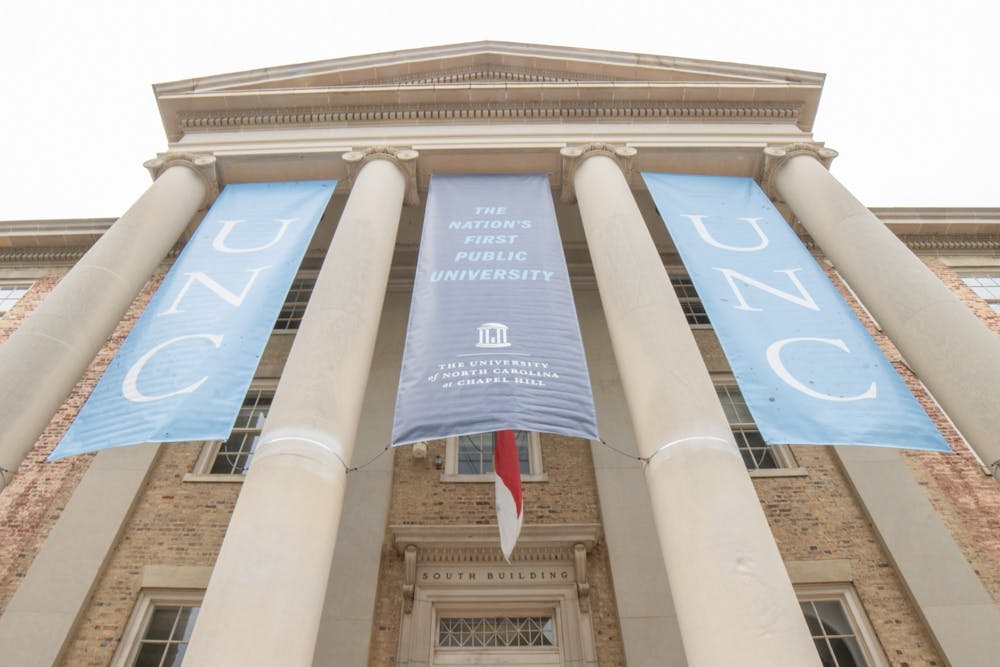Water testing is taking place in a phased approach that will last "multiple weeks," according to a campus announcement on Sept. 27 from Environment, Health and Safety.
The first phase will prioritize fixtures that may potentially contain lead components based on age and construction. Phase two will test water fixtures in buildings built in or prior to 1930. The last phase will test all buildings built in or prior to 1990.
During testing, fixtures are removed from service until results return. If traces of lead are discovered, fixtures will be removed from service completely and building occupants will be notified.
Powell Marshall, director of UNC Facilities Shared Services, said only "trace amounts" of lead had been discovered, according to emails obtained by The Daily Tar Heel sent to the occupants of Hamilton and Fordham Halls.
However, many lead samples exceeded the threshold of 15 parts per billion (ppb) — the amount set by the EPA requiring water systems to take action.
The University said it will take action for any measurable level of lead detected, according to the Sept. 26 notifications sent to the occupants of Carrington and Issac M. Taylor Halls.
Fordham Hall
On the third floor, a drinking fountain initially had non-detectable levels of lead. The second flushing resulted in a sample of 662 ppb, over 44 times the threshold.
Hamilton Hall
On the second floor, a drinking fountain contained 5.8 ppb on first flush and 34 ppb on the second.
On the fourth floor, a drinking fountain contained 2.8 ppb on first flush and 7.2 ppb on the second.
On the fifth floor, a drinking fountain contained 9.6 ppb on first flush and 402 ppb on the second, nearly 27 times the threshold's guidance.
To get the day's news and headlines in your inbox each morning, sign up for our email newsletters.
Manning Hall
A basement drinking fountain initially had lead levels of 4.5 ppb. The second test yielded no detectable levels.
Phillips Hall
A first-floor drinking fountain had 26.3 ppb initially, and after further testing resulted in 4.1 ppb of lead.
South Building
A basement drinking fountain detected 515 ppb of lead first, then resulted in 254 ppb.
Wilson Library
In total, four drinking fountains and 14 sinks were found to have detectable levels of lead. Further testing was completed after the University announced on Sept. 1 that three water fountains had detectable levels of lead, including a second-floor fountain with 193 ppb.
Carrington Hall
Eight drinking fountains were revealed to have detectable levels of lead:
- Ground floor (beside room L10): 6.44 ppb initially, then non-detectable
- First-floor (across from room 104): 69.6 ppb initially, then 81.0 ppb
- Second-floor (across from room 206A): 6.9 ppb initially, then non-detectable
- Second-floor (across from room 254A): 7.51 ppb initially, then non-detectable
- Third-floor (across from room 306): 44.6 ppb initially, then 36.7 ppb
- Fourth-floor (across from room 411): 39.9 ppb initially, then 31.5 ppb
- Fourth-floor (across from room 454A and elevators): 6.29 ppb initially, then 5.39 ppb
- Fifth-floor (across from room 511): 10.6 ppb initially, then 7.89 ppb
Issac M. Taylor Hall
A fifth-floor drinking fountain near the women's restroom had 7.52 ppb of lead on first test and 5.17 ppb on the second.
A basement water cooler first came back with non-detectable levels of lead, but had 138 ppb on the second sample.
Testing and community updates
The University is offering lead testing for UNC faculty, staff and students who work or study in the affected buildings at no charge, according to a Sept. 27 campus announcement.
After consultation with campus medical providers, lead level blood testing will be provided based on suspected exposure and health conditions, such as pregnancy and communicated symptoms.
Students with concerns can contact Campus Health at 919-966-2281, with appointments generally available within one to two days. Employees can contact the University Employee Occupational Health Clinic at 919-966-9119, with appointments available within two to three days.
Blood tests will be sent to LabCorp and results should be communicated within two to three days.
Visitors or other Chapel Hill residents are advised to contact their health care providers.
As of Sept. 21, the University was working on a system for lead testing, but was only prioritizing testing for pregnant or breastfeeding adults.
The University has also created a page on the Environmental, Health and Safety website that focuses on campus drinking water, the safety status of the water and community updates.
@forepreston
university@dailytarheel.com



